I’d seen it on maps but I’d never really heard much about Great Basin. What exactly was it famous for? Listed as one of the 10 least-visited national parks in the US, this sounded like the ideal remote experience for 2020 quarantine camping! So, I penciled it into our itinerary. It was the perfect way to break up our drive from Utah to Crater Lake and explore what this corner of Nevada had to offer.
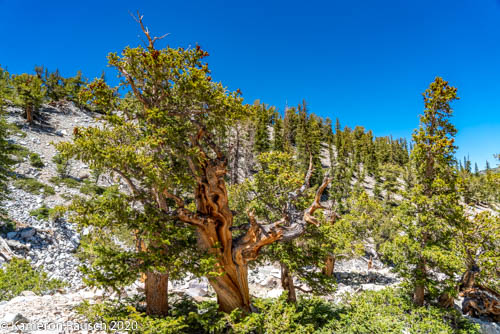
Approaching the Park
As the sun sank lower and lower on the horizon, we scoured the barren land for signs of another driver….. nothing…. we literally passed ONE (broken down semi truck) on the 100 mile stretch between Delta, Utah and Great Basin National Park. “The Loneliest Road in America” definitely lived up to its name.
While the drive wasn’t difficult (highway 50 is flat, paved, and seemingly well maintained), this road, stretching across the salt flats and deserts of the Great Basin of the western United States, is the most desolate we have ever encountered. More than once we wondered exactly where we were going to camp at the end of the 100 deserted miles.
But fear not! This national park genuinely earns its designation. It is an oasis in the middle of approximately 190,000 square miles of desert and salt flats that encompass most of Nevada, and parts of California, Oregon, Utah, and Idaho. It is in such stark contrast to the surrounding landscapes, that we appreciated it all the more.
What is The Great Basin?
Basin = Bowl-shaped or natural depression in the earth’s surface
Great Basin National Park is named after the enormous basin that the Snake Mountains rise up out of. It is a beautiful example of how these mountain “islands” provide oases for wildlife and hardy vegetation in the otherwise unforgiving desert. From the sparse sagebrush of the basin to the thousands of years old Bristlecone Pine Trees leading up to the 13,063 ft summit of Wheeler Peak, Great Basin packs in a wide variety of flora, fauna, and landscapes in it’s 77,000-odd acre park.
Much of this basin used to be an enormous landlocked saltwater lake called Lake Bonneville. The Great Salt Lake is the only remnant left of this giant lake whose shoreline was about 10 miles from modern-day Great Basin National Park. Today, any precipitation that does drain into the basin stays and evaporates as there are no drainage outlets to larger bodies of water.
What to do?
Camp! There really is not a lot of infrastructure surrounding the park. Camping, therefore, is the best way to enjoy your stay. We camped one night at Baker Creek and 3 nights at Upper Lehman Creek. Both campgrounds had a nice variety of sites – but many were quite tight for anything over a 20 foot trailer or even a 20 foot RV. They would be fantastic for tent camping, too, with a variety of sizes and vegetation to choose from. When we visited, both sites were still first-come, first-serve. However, as of 2021, you are able to reserve ahead of time online. This will be a fantastic addition to this park. It is so far away from major cities or other organized camping, that it would be disappointing to make the trek and end up without a spot. Both campgrounds were 100% full all 4 nights we were there. Each site had fire rings and picnic tables. There was fresh water near the bathrooms that we used to fill up our drinking jug. Our sites were pretty level, but there were definitely some that would’ve been tight or quite unlevel. Check out the photos on http://campsitephotos.com https://www.campsitephotos.com/campground/nv/great-basin-national-park/ to help you decide which is the best site for you.
Hike! Now, hiking at 10,000ft takes a bit of acclimatization and grace for your body to cooperate, but it’s well worth it here! We tackled a few different hikes and would repeat them all in a heartbeat. There are definitely more challenging hikes than these in the park, however, these two hikes were perfect length and difficulty for our 4 boys (ages 6-11):
Alpine Lakes Loop: (2.7 miles, starting elevation 9,800ft, 600 foot elevation gain) Sun dappled leaves flicker in the breeze above while deer quietly graze within 20 yards of the trail. This trail meanders in and out of Aspen and evergreen trees, over small rocks and tree roots. Crystal clear lakes lay in the shadows of the towering peaks above. This is a moderately-easy trail without any steep drop-offs.
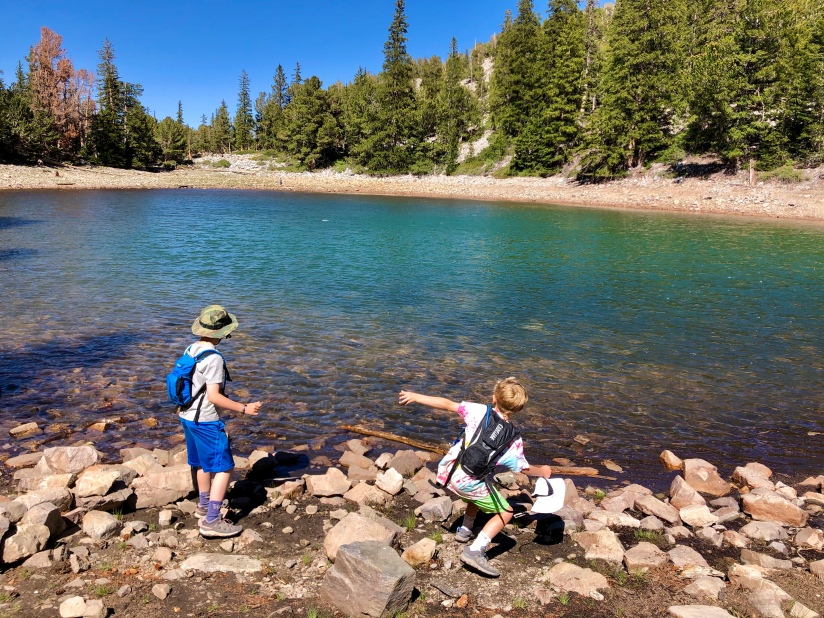
Teresa Lake 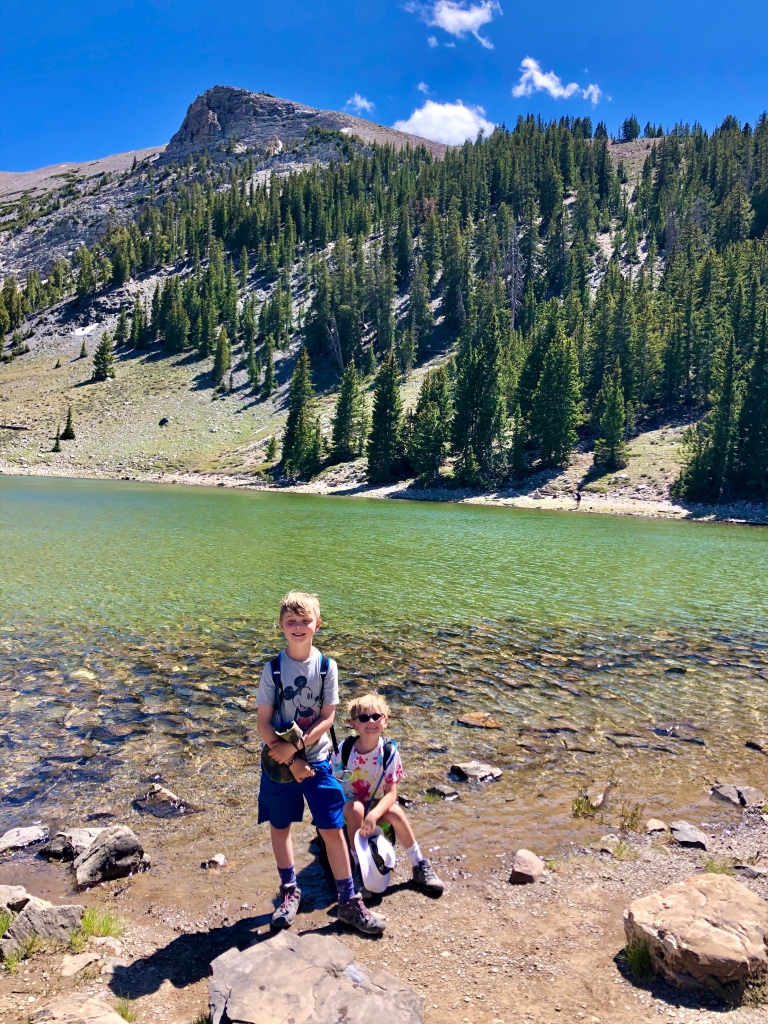
Beautiful Stella Lake 
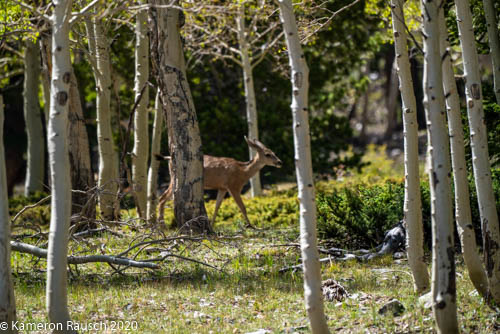

Bristlecone Trail: (2.8 miles, starting elevation 9,800 feet, 600 foot elevation gain). Ascending up switchbacks from the Alpine Lakes Loop Trail, this trail brings you up to some of the oldest trees in the world. These amazing Bristlecone Pines are up to 5,000 years old, and stubbornly eek out their lives in the exposed, harsh hillsides of this trail. Well worth the 2 hours we spent hiking to see these trees, this trail felt more strenuous than the Alpine Lakes Loop we had hiked the day before. Maybe it was the steep hillside we were hiking up? We also continued past the Bristlecone Grove to see the glacier (and find some snow!). It was a welcome motivator for our kiddos.
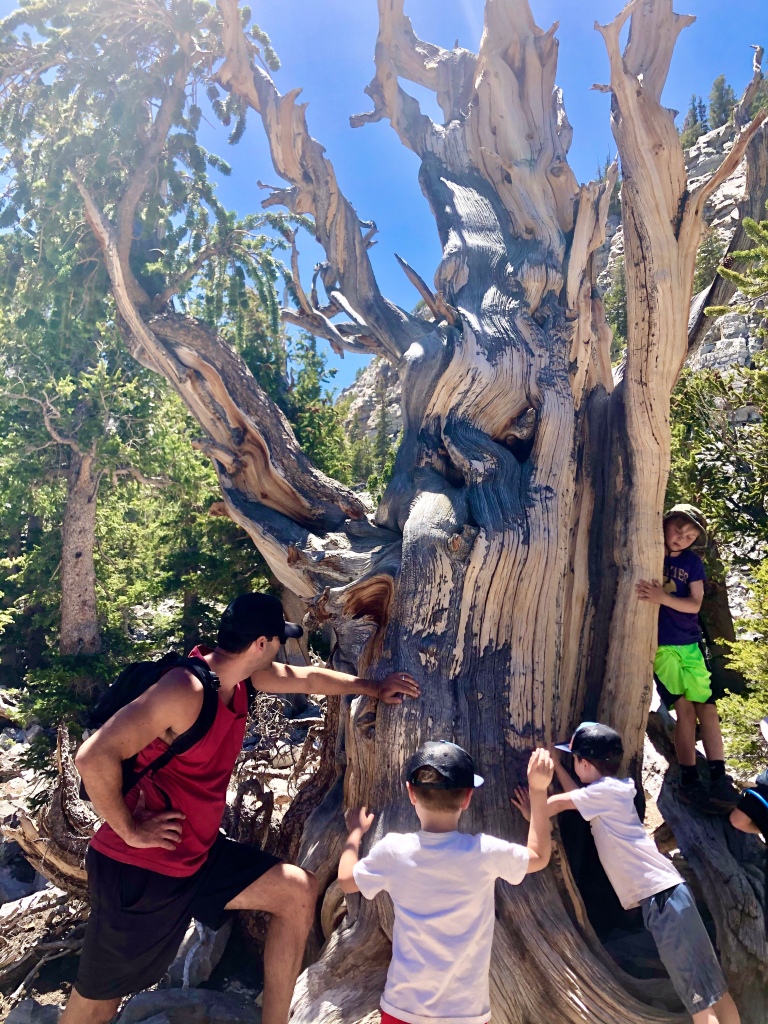
Scenic Drive! As you climb up the 12-mile scenic drive from the Lehman Campgrounds to Wheeler Peak, the entire Great Basin opens up below you. It is a spectacular view. You will notice that there is a vehicle length limit (of 24 ft trailers/vehicles) for good reason. This road is quite narrow and windy with steep drop-offs (without guardrails) on the cliff side of the road. I was white knuckled as we skirted the edge but the rest of the passengers really enjoyed the drive (read: no fear of heights for them)!
Go Spelunking! Lehman Caves: While closed due to COVID while we visited, this cave is filled with beautiful formations that will surely thrill any spelunker. It is .25 miles deep and 2 miles long. Normally reservations can be made online through recreation.gov or in person at the Lehman Caves Visitor’s Center. We definitely will pay this a visit next time we are in the area.
Stargaze! The crystal-clear desert skies afford many nights of pristine star gazing. The visitor’s center has a listing of current star programs including star-gazing in the parking lot at Lehman Caves Visitor Center and full-moon hikes.
Fish! While we camped at Upper Lehman, the rangers were busy building fish ladders on Lehman Creek which runs through the upper and lower campgrounds. The water is crystal clear and you can see the fish as they swim by and hangout in the pools. It was fantastic fun for the budding anglers in our group. Most of the fish were pretty small, so it was just catch and release, but the boys caught about 8 fish a day in this river. Great Basin follows the Nevada fishing regulations and a license is required for everyone 12 and older. The annual license also requires a trout stamp. The park does not sell fishing licenses – the closest place to purchase them is at the Border Inn (12 miles from the park) on Highway 50.

Four Legged Friends and Other Creatures
We always camp with our pup (he is a big reason we got a camper) and are used to not being able to bring him on trails in National Parks. Great Basin isn’t any different. Leashed dogs are restricted to paved roads and campgrounds. But, since the elevation of the campground was 7,700ft, it was cool enough to leave him in the trailer while we did a few day hikes, even on the full sunny days in early July.
Mice…… Until our trip to Utah, we had never had any hitchhiking critters to contend with. Well, that streak of luck ended near Goblin Valley, so we came armed with a variety of mouse traps we picked up before we arrived at Great Basin. Little did we know, but Great Basin also had a HUGE rodent population. The mice literally started scurrying around our campsite as soon as the sun went down. We removed all food from the drawers the mice had gotten into previously, and placed traps in there instead. We definitely battled these critters the entire time we were in the park. The rangers have been having discussions about how to handle this infestation, so hopefully by the time you visit, it won’t be a problem. But, I would come armed with a variety of mouse traps just in case!
When to Visit?
We visited the first week in July and the weather was perfect for hiking and enjoying the scenery. Wildflowers were blooming, trails were clear from snow, the road to Wheeler Peak was open, and it wasn’t too dry so we could still have campfires. If you want to head up to Wheeler Peak for the trails we listed above, you will need to come in the summer time (the road is closed in the winter). But, if you’re more interested in the caves and lower elevation hikes, these would be great in any season. Lower Lehman Campground is open year round.







